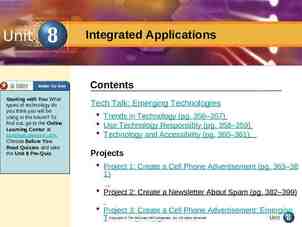Microsoft Azure Overview Ken Casada Technical Evangelist Microsoft
34 Slides4.37 MB
Microsoft Azure Overview Ken Casada Technical Evangelist Microsoft Switzerland [email protected]
Microsoft Azure Flexible Open Solid
Global Footprint
Pay only for what you use
Windows Azure – Running your Apps Infrastructur e Services (VM) Cloud Services Web Sites Mobile Services Applications Multi-tier Apps Web Apps Mobile Apps Data Data Data Data Firewall Rules Service Model Virtual Network O/S Focus on the Application
IaaS (VM & VNET) Windows Server and Linux Virtual Private Networking Capabilities (VNET)
Does Your App Need a Virtual Network? IP Address Requirements Virtual Machines deployed into a virtual network have an infinite DHCP lease (not static but effectively the same thing) Deploy apps in the cloud that requires Active Directory Windows Azure VM 1 Subnet 2 VM 2 ROLE 1 Subnet 1 Hybrid On-Premises Cloud Apps Requirement for connectivity between your data center and the public cloud Connectivity between cloud services Connecting a PaaS to IaaS Service (for better Corpnet
Creating a Virtual Private Network
Creating a Virtual Private Network
How does a private IP get allocated to- One a VM? of the available IP addresses is allocated as the VM is allocated! - The IP address remains the same as long as the VM is allocated. New: - You can statically set a private IP address to a VM (today only via PowerShell) - How? Configure a Static Internal IP Address (DIP) for a VM
Virtual Machines Demo
Built-In Extensions by Microsoft (Demo Summary) BGInfo Extension Display useful server information to the desktop as a wallpaper VMAccess Extension Did you previously lost your IaaS VM password? Are the RDP settings of the VM broken? With VMAccess you can now reset the password and the username !!! Custom Script Extension Allows you to specify a powershell script file to run in the VM immediately after it’s created. http ://blogs.msdn.com/b/windowsazure/archive/2014/04/24/automating-vm-customization-tasks-using-custom-script-extension.aspx
Built-In Extensions by Microsoft (Demo How to enable/ disable BGInfo/VMAccess extensions? Summary) How to reset a VM password? How to fix RDP settings?.by using the VMAccess extension . http:// blogs.msdn.com/b/windowsazure/archive/2014/04/11/vm-agentand-extensions-part-1.aspx How to add the VM Agent on existing VMs? http:// blogs.msdn.com/b/windowsazure/archive/2014/04/15/vm-agentand-extensions-part-2.aspx
EndPoint (Demo Summary) All VM within the same cloud service or VNET can automatically communicate to each other using a private network channel! All other inbound communication (such as traffic initiated from Internet hosts) requires an endpoint. Default Endpoints are created in order to remotely administer your machine Remote Desktop Protocol (RDP) Endpoint Windows OS PowerShell Endpoint Windows OS Secure Shell (SSH) Endpoint Linux OS Tip: it is possible to define ACL (Access Control List) at the Endpoint level (see http://msdn.microsoft.com/library/azure/dn376541.aspx) Deny or permit traffic to the endpoint based on remote subnet IPv4 address range
Load Balanced Set (Demo Summary) mycloudservicednsname EndPoint Public Port (80) Local/Private Port (80) Protocol (TCP/UDP) Name http:// mycloudservicednsname.cloudapp.net:8 0 Cloud Service Public Port 80 LB Port 80 VM1 Port 80 VM2 Port 80 VM3 Single Public IP Per Cloud Service (VIP)
Load Balancer Probes (Demo Summary) Load Balancer Probe (default) Set Name Protocol (TCP/HTTP) Probe Port Probe Interval Cloud Service Port 80 VM1 Port 80 VM2 Port 80 VM3 TCP Probe Public Port 80 LB
Load Balancer Custom Probes (Demo Summary) Load Balancer Probe (custom) Set Name Protocol (TCP/HTTP) Probe Port Probe Interval Cloud Service Port 80 VM1 /healthcheck.aspx Public Port 80 LB Port 80 VM2 /healthcheck.aspx Port 80 VM3 /healthcheck.aspx
What’s new in Networking? How does a private IP address get allocated to a VM? - One of the available IP address is allocated as the VM is allocated - The IP address remains the same as long as the VM is allocated. New: - You can statically set a private IP address to a VM (today only via PowerShell) - How? Configure a Static Internal IP Address (DIP) for a VM Public IP Reservations (http://msdn.microsoft.com/en-us/library/dn690120.aspx) - you can have static public IP addresses - up to 5 for free Instance-Level Public IP Addresses (http://msdn.microsoft.com/en-us/library/dn690118.aspx) - Public address that can be assigned directly to the VM (rather than to the cloud service that your VM resides within) - i.e. (Outbound traffic originating from the VM goes out with PIP as the source and this uniquely identifies the VM to external entities) Internal Load Balancing support between VMs that don’t have public facing endpoints (enables to load-balance VM with a private IP address) - Accessible to VM within the same VNET or Cloud Service
Web Sites Build with popular web framework (ASP.NET, PHP, Java, Python or Node.js) With a SQL DB or MySQL database Deploy in seconds with WebDeploy, FTP Source Control Deployment (ex. Git/TFS ) Start for free, scale up as your traffic
Web sites Demo
Cloud Services (PaaS) Automated application management Support rich multi-tier architectures Web Role / Worker Role Build stateless highly scalable apps and services
Deploying a cloud service
Packaging and Deployment (Paas) Microsoft Visual Studio Web Role Worker Role Packag e *.cspk g Config *.cscfg Upload to Windows Azure Storage Service Package Network Load Balancer Windows Azure Fabric Controller
Monitoring (Paas) Windows Azure Fabric Controller Network Load Balancer Package
What is a Cloud Service? A collection of related service roles Web Role Worker Role
Big data Database Application building blocks Media Storage Traffic Caching Messaging CDN Networkin g Identity
Azure SQL Relational SQL Server Engine in the Cloud Database Fully Managed Service DB Enteprise-Ready with automatic support for HA Designed to scale out elastically with demand Azure SQL Database ! SQL Server SQL Server Feature Limitations (Azure SQL Database)
Cache Low latency, in-memory distributed cache 3 Types of Cache: Azure Redis Cache (preview) Managed Cache Service In-Role Cache (only for Cloud Services app) We recommend all new developments use the Azure Redis Cache!!! Learn more here: http ://azure.microsoft.com/en-us/documentation/services/cache/# redis Azure Redis Cache (Preview)
Traffic Manager Traffic
Windows Azure Traffic Manager Intelligently directs requests from users across instances of an app deployed in different Azure datacenter Support for external Endpoints (outside Azure)!!!! Policy options: -Performance: all requests sent to the closest datacenter -Failover: all requests sent to specified datacenter, unless not available datacenter is
Media Services Media
What Do We Mean by Media Your Choice of Components for Building Custom Media Services? Workflows in the Cloud (you only pay for what you use) Windows Azure Media Services “The Media Services team is working on a long list of upcoming blog updates for the week of the International Broadcasters Convention in Amsterdam starting on On-Demand Live Format Content Advertisi Ingestion September 10th,Encoding so stayConversio tuned for more details on our LiveAnalytics Streaming and Content Protection Streaming Streaming ng protection services” n from John Deutscher is currently the Principal Program Manager Lead for Azure Media Services . Live Streaming: currently in private preview Analytics: will be rolled out as they become available
Mobile Services Easily build cloud back-ends Data, identity, push notifications, and scheduled scripts Windows Store, Windows Phone, iOS, and Android, Xamarin,
Break







































